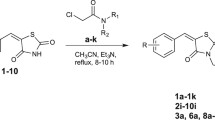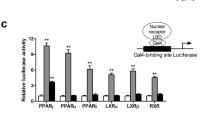Summary
Numerous studies have documented that various naturally derived ligands or synthetic non-thiazolidinediones (TZD) as peroxisome proliferator-activated receptor gamma (PPARγ) agonists have shown moderate or potent antitumor activities, which is PPARγ independent or partially dependent. However, the PPARγ agonistic or glucose-lowering activity is ranked first more often than antitumor activity to determine promising novel PPARγ agonists for potential clinical use. In this study, we hypothesized that there might exist some compounds with less PPARγ agonistic activity but potent antitumor activity. Thereafter, we evaluated the PPARγ agonistic and antitumor activity of a novel series of α-aryloxy-α-methylhydrocinnamic acid derivatives synthesized with the initial aim of developing novel PPARγ agonists as hypoglycemic agents. MTT assay results revealed that several compounds were able to inhibit cell proliferation in a dose-dependent manner with IC50 12.7–29.7 μM, better than that of rosiglitazone (45.9–141 μM), although the PPARγ agonistic activity of most compounds is much lower than rosiglitazone. Some compounds induced cell cycle arrest and apoptosis tested by Flow Cytometry. Oral administration of DH9 (100 mg/kg/d) for 21 days to BALB/c nude mice bearing xenografts including MGC-803, NCI-H460, HT-29 and OS-RC-2 cells significantly retarded tumor growth. DG8 and DJ5 showed benefits in some of the above four xenografts. Our findings demonstrate that these compounds have potent antitumor activity in vitro and in vivo and pyrimidinyl-arylpropionic acid derivatives might be viable resources in the development of new antineoplastic agents






Similar content being viewed by others
References
Berger J, Moller DE (2002) The mechanisms of action of PPARs. Annu Rev Med 53:409–435
Willson TM, Lambert MH, Kliewer SA (2001) Peroxisome proliferator-activated receptor gamma and metabolic disease. Annu Rev Biochem 70:341–367
Lin MS, Chen WC, Bai X, Wang YD (2007) Activation of peroxisome proliferator-activated receptor gamma inhibits cell growth via apoptosis and arrest of the cell cycle in human colorectal cancer. J Dig Dis 8:82–88
Xiong X, Ye Y, Fu L, Dai B, Liu J, Jia J, Tang J, Li L, Wang L, Shen J, Mei C (2008) Antitumor activity of a novel series of alpha-aryloxy-alpha-methylhydrocinnamic acid derivatives as PPAR gamma agonists against a panel of human cancer cell lines. Invest New Drugs 27(3):223–232
Guo YT, Leng XS, Li T, Zhao JM, Lin XH (2004) Peroxisome proliferator-activated receptor gamma ligands suppress liver carcinogenesis induced by diethylnitrosamine in rats. World J Gastroenterol 10:3419–3423
Borbath I, Leclercq I, Moulin P, Sempoux C, Horsmans Y (2007) The PPARgamma agonist pioglitazone inhibits early neoplastic occurrence in the rat liver. Eur J Cancer 43:1755–1763
Kubota T, Koshizuka K, Williamson EA, Asou H, Said JW, Holden S, Miyoshi I, Koeffler HP (1998) Ligand for peroxisome proliferator-activated receptor gamma (troglitazone) has potent antitumor effect against human prostate cancer both in vitro and in vivo. Cancer Res 58:3344–3352
Kebebew E, Peng M, Reiff E, Treseler P, Woeber KA, Clark OH, Greenspan FS, Lindsay S, Duh QY, Morita E (2006) A phase II trial of rosiglitazone in patients with thyroglobulin-positive and radioiodine-negative differentiated thyroid cancer. Surgery 140:960–966
Grommes C, Landreth GE, Heneka MT (2004) Antineoplastic effects of peroxisome proliferator-activated receptor gamma agonists. Lancet Oncol 5:419–429
Vogt T, Hafner C, Bross K, Bataille F, Jauch KW, Berand A, Landthaler M, Andreesen R, Reichle A (2003) Antiangiogenetic therapy with pioglitazone, rofecoxib, and metronomic trofosfamide in patients with advanced malignant vascular tumors. Cancer 98:2251–2256
Choi IK, Kim YH, Kim JS, Seo JH (2008) PPAR-gamma ligand promotes the growth of APC-mutated HT-29 human colon cancer cells in vitro and in vivo. Invest New Drugs 26:283–288
Smith MR, Kantoff PW (2002) Peroxisome proliferator-activated receptor gamma (PPargamma) as a novel target for prostate cancer. Invest New Drugs 20:195–200
Diamond GA, Kaul S (2007) Rosiglitazone and cardiovascular risk. N Engl J Med 357:938–939
Nathan DM (2007) Rosiglitazone and cardiotoxicity-weighing the evidence. N Engl J Med 357:64–66
Psaty BM, Furberg CD (2007) The record on rosiglitazone and the risk of myocardial infarction. N Engl J Med 357:67–69
Devasthale PV, Chen S, Jeon Y, Qu F, Shao C, Wang W et al (2005) Design and synthesis of N-[(4-methoxyphenoxy)carbonyl]-N-[[4-[2-(5-methyl-2-phenyl-4-oxazolyl)ethoxy]phenyl]methyl]glycine [Muraglitazar/BMS-298585], a novel peroxisome proliferator-activated receptor alpha/gamma dual agonist with efficacious glucose and lipid-lowering activities. J Med Chem 48:2248–2250
Ahn JH, Shin MS, Jung SH, Kang SK, Kim KR, Rhee SD et al (2006) Indenone derivatives: a novel template for peroxisome proliferator-activated receptor gamma (PPARgamma) agonists. J Med Chem 49:4781–4784
Kim KR, Lee JH, Kim SJ, Rhee SD, Jung WH, Yang SD et al (2006) KR-62980: a novel peroxisome proliferator-activated receptor gamma agonist with weak adipogenic effects. Biochem Pharmacol 72:446–454
Ray DM, Akbiyik F, Phipps RP (2006) The peroxisome proliferator-activated receptor gamma (PPARgamma) ligands 15-deoxy-Delta12, 14-prostaglandin J2 and ciglitazone induce human B lymphocyte and B cell lymphoma apoptosis by PPARgamma-independent mechanisms. J Immunol 177:5068–5076
Papineni S, Chintharlapalli S, Safe S (2008) Methyl 2-Cyano-3, 11-dioxo-18beta-olean-1, 12-dien-30-oate is a peroxisome proliferator-activated receptor-gamma agonist that induces receptor-independent apoptosis in LNCaP prostate cancer cells. Mol Pharmacol 73:553–565
Chintharlapalli S, Papineni S, Safe S (2007) 1, 1-bis(3′-indolyl)-1-(p-substitutedphenyl)methanes inhibit growth, induce apoptosis, and decrease the androgen receptor in LNCaP prostate cancer cells through peroxisome proliferator-activated receptor gamma-independent pathways. Mol Pharmacol 71:558–569
Ray DM, Morse KM, Hilchey SP, Garcia TM, Felgar RE, Maggirwar SB et al (2006) The novel triterpenoid 2-cyano-3, 12-dioxooleana-1, 9-dien-28-oic acid (CDDO) induces apoptosis of human diffuse large B-cell lymphoma cells through a peroxisome proliferator-activated receptor gamma-independent pathway. Exp Hematol 34:1202–1211
Han S, Zheng Y, Roman J (2007) Rosiglitazone, an Agonist of PPARgamma, Inhibits Non-Small Cell Carcinoma Cell Proliferation In Part through Activation of Tumor Sclerosis Complex-2. PPAR Res 2007:29632
Rau O, Syha Y, Zettl H, Kock M, Bock A, Schubert-Zsilavecz M (2008) Alpha-Alkyl substituted pirinixic acid derivatives as potent dual agonists of the peroxisome proliferator activated receptor alpha and gamma. Arch Pharm (Weinheim) 341:191–195
Kusunoki N, Yamazaki R, Kitasato H, Beppu M, Aoki H, Kawai S (2004) Triptolide, an active compound identified in a traditional Chinese herb, induces apoptosis of rheumatoid synovial fibroblasts. BMC Pharmacol 4:2
Aoki T, Asaki T, Hamamoto T, Sugiyama Y, Ohmachi S, Kuwabara K et al (2008) Discovery of a novel class of 1, 3-dioxane-2-carboxylic acid derivatives as subtype-selective peroxisome proliferator-activated receptor alpha (PPARalpha) agonists. Bioorg Med Chem Lett 18:2128–2132
Asaki T, Aoki T, Hamamoto T, Sugiyama Y, Ohmachi S, Kuwabara K et al (2008) Structure-activity studies on 1, 3-dioxane-2-carboxylic acid derivatives, a novel class of subtype-selective peroxisome proliferator-activated receptor alpha (PPARalpha) agonists. Bioorg Med Chem 16:981–994
Casimiro-Garcia A, Bigge CF, Davis JA, Padalino T, Pulaski J, Ohren JF et al (2008) Effects of modifications of the linker in a series of phenylpropanoic acid derivatives: Synthesis, evaluation as PPARalpha/gamma dual agonists, and X-ray crystallographic studies. Bioorg Med Chem 16:4883–4907
Reddy RC, Keshamouni VG, Jaigirdar SH, Zeng X, Leff T, Thannickal VJ et al (2004) Deactivation of murine alveolar macrophages by peroxisome proliferator-activated receptor-gamma ligands. Am J Physiol Lung Cell Mol Physiol 286:L613–L619
Chou FS, Wang PS, Kulp S, Pinzone JJ (2007) Effects of thiazolidinediones on differentiation, proliferation, and apoptosis. Mol Cancer Res 5:523–530
Han S, Roman J (2007) Peroxisome proliferator-activated receptor gamma: a novel target for cancer therapeutics? Anticancer Drugs 18:237–244
Schoonjans K, Staels B, Auwerx J (1996) The peroxisome proliferator activated receptors (PPARS) and their effects on lipid metabolism and adipocyte differentiation. Biochim Biophys Acta 1302:93–109
Acknowledgements
This work was supported by grants from the National 863 Plan in High Technology Progress (2002AA2Z3130, 2007AA02Z3Z1), and Shanghai Leading Academic Discipline Project (Project Number: B902). We thank members of the Shanghai Institute of Materia Medica, Chinese Academy of Sciences for design and synthesis of the novel compounds. We thank Dr Huimin Hu for helpful discussions.
Author information
Authors and Affiliations
Corresponding authors
Additional information
Xishan Xiong and Li Wang contributed equally to this work.
Rights and permissions
About this article
Cite this article
Xiong, X., Wang, L., Ye, Y. et al. Pyrimidinyl-arylpropionic acid derivatives: viable resources in the development of new antineoplastic agents. Invest New Drugs 28, 472–481 (2010). https://doi.org/10.1007/s10637-009-9278-9
Received:
Accepted:
Published:
Issue Date:
DOI: https://doi.org/10.1007/s10637-009-9278-9




